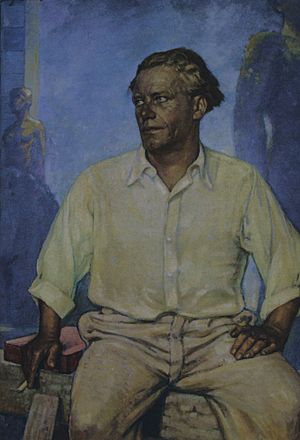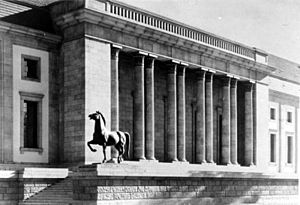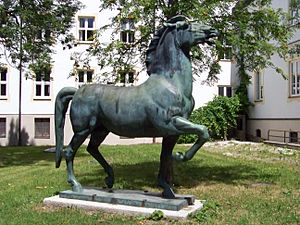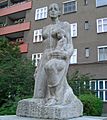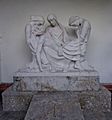Josef Thorak facts for kids
Josef Thorak (born February 7, 1889, in Vienna, Austria; died February 26, 1952, in Bad Endorf, Bavaria) was an Austrian-German artist who made sculptures. He became famous for creating very large statues, especially of male figures. He was one of the most important sculptors during the time when the Nazi Party ruled Germany, known as the Third Reich.
Contents
Early Life and Art Training
Josef Thorak was born in Vienna. His father was from East Prussia, and his mother was from Salzburg. When he was young, he went to a religious boarding school. His schooling ended after an accident in 1898.
In 1903, he started learning to be a potter in Slovakia. After finishing this training, he worked in a factory in Vienna. He also took art classes from a sculptor named Anton Hanak. From 1911 to 1915, he studied sculpture at the Academy of Fine Arts in Vienna. He also served in the First World War for two periods.
Later, he got a studio in Berlin and joined the Berlin Secession, a group of artists. His art style was mostly classical, but it also showed some expressionist influences.
Becoming a Famous Sculptor
In Berlin during the 1920s, Thorak mostly earned money by designing monuments for soldiers' graves. He also helped wealthy friends with their design projects. Important people like Hjalmar Schacht, who led the German central bank, and Wilhelm von Bode, a museum director, helped him a lot. Wilhelm von Bode even wrote a book about Thorak's art in 1929. Thorak won a state art prize in 1928. To seem more important, he started calling himself "professor."
When Germany faced tough economic times in the late 1920s and early 1930s, Thorak got fewer art jobs. In 1932, he designed decorations for a church. He also entered his sculptures in the art competition at the 1932 Summer Olympics.
Working for the Nazi Party
After the Nazis took power in 1933, Thorak used his friendships with many important members of the Nazi Party. He completed a large monument in Ankara, Turkey, after his former teacher Anton Hanak died. He also sculpted busts (head and shoulder statues) of important leaders like Joseph Goebbels, Mustafa Kemal Atatürk, and Józef Piłsudski. In 1934, he made a death mask of Paul von Hindenburg. In 1940, a bust he made of Benito Mussolini was given as an official gift by Hitler. He even stayed at Hitler's home for several days in 1936 to sculpt a bust of Hitler.
Alfred Rosenberg, another Nazi leader, arranged a special art show just for Thorak in 1935. Thorak became very rich. In 1937 or 1938, he bought a large estate called Schloss Hartmannsberg in Bavaria. In 1943, he also got another estate, Schloss Prielau. This property had been taken from the family of Hugo von Hofmannsthal because they were Jewish. Thorak collected old carvings and furniture, some of which came from art dealers who worked with the Nazis to take art from others.
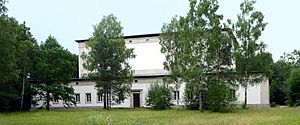
Thorak and another sculptor named Arno Breker became the two main "official sculptors" for the Nazi government. In 1937, Thorak became a professor of sculpture at the Munich Academy of Fine Arts. In 1939, Hitler ordered that a special studio be built for Thorak in Baldham, designed by Albert Speer. Even though Thorak didn't join the Nazi Party until 1941, Hitler made his membership seem like it started in 1933.
After visiting Thorak's studio in 1937, Joseph Goebbels wrote in his diary that Thorak was "our greatest sculptural talent." Albert Speer, a top Nazi architect, later called Thorak "more or less my sculptor" because Thorak often made statues and reliefs for Speer's buildings.
Later Life and Death
After the Second World War, Thorak first made decorative ceramics. Then, he focused on religious sculptures. In 1948, he was officially cleared of his connections to the Nazi Party. After two more reviews, he was finally cleared in 1951. In July 1950, he was allowed to have one last art show at the Mirabell Palace in Salzburg. Many people came to see it, but the reviews were not very good. His Austrian citizenship was given back to him in 1951.
Josef Thorak died in February 1952 at his home, Schloss Hartmannsberg, in Bavaria. He was buried with his mother in St. Peter's cemetery in Salzburg.
Family Life
Thorak was married three times. In 1918, he married Hertha Kroll. They had two sons. They divorced in 1926 but continued to live together until Hertha died in 1928.
The next year, he married Hilda Lubowski. They had a third son. However, after the Nazis took power in 1933, they agreed to divorce because Hilda had Jewish family. She moved to France in 1939 and later to England.
In 1946, Thorak married Erna Hoenig, an American woman. Their son was born in 1949.
Famous Artworks
- 1922: Der sterbende Krieger (The Dying Warrior), a memorial for the World War I in Ustka, Poland.
- 1928: Heim (Home) and Arbeit (Work), in Charlottenburg, Berlin.
- 1936: Boxer, a statue based on the famous boxer Max Schmeling, made for the Olympic Stadium in Berlin.
- 1937–43: Goddess of Victory group of sculptures for the Nazi party meeting grounds in Nuremberg, which was never finished.
- 1940: Der königliche Reiter (The Royal Rider), a model for a large statue of Frederick the Great in Linz.
- 1941: Couple.
- 1942: Letzter Flug (Last Flight), a wartime sculpture of a woman holding a dead soldier.
- The Judgement of Paris, made for a fountain.
- 1943: Paracelsus, a sculpture made for Salzburg.
- 1943: Copernicus, also in Salzburg.
- Denkmal der Arbeit (Monument to Work), a large sculpture for the German highways. It showed a group of workers trying to move a huge rock.
The Striding Horses of the Reich Chancellery
In 1939, Thorak created three very large horse statues, each about 3 meters (10 feet) tall. They were meant for the Nuremberg rally grounds. Two of these horses were placed outside the Reich Chancellery, a large building designed by Albert Speer.
In May 2015, these two horses were found during a police raid in a storage building in Germany. They had been moved in 1989 from a military base in East Germany, where they had been since after the Second World War.
The third Thorak horse was shown in an art exhibition in Munich in 1939. It later stood outside Thorak's studio. In August 2015, this third horse was found at a boarding school in Ising, Bavaria. Thorak's wife had given it to the school in 1961 instead of paying tuition fees for her son.
Awards and Recognition
Thorak received the main prize from the Prussian Academy of Arts in 1928. In 1934, he received a special golden medal from the Pope for his work in an art exhibition. In 1937, he was nominated for the first German National Prize for Art and Science. A street in Salzburg was named after him in 1963.
Images for kids
-
Home (1928) in Charlottenburg
-
Paracelsus (1943) in Salzburg
See also
 In Spanish: Josef Thorak para niños
In Spanish: Josef Thorak para niños
- Nazi art
- Nazi architecture


